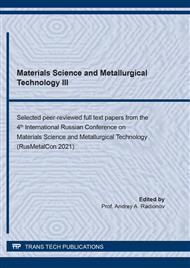[1]
A. Cavaleiro, J.T. de Hosson, Nanostructured Coatings, Springer Science & Business Media, New York, (2007).
Google Scholar
[2]
S.M. Aquadi, B. Luster, P. Kohli, C. Muratore, A.A. Voevodin, Progress in the development of adaptive nitride-based coatings for high temperature tribological applications, Surf. Coat. Technol. 204 (2009) 962-968.
DOI: 10.1016/j.surfcoat.2009.04.010
Google Scholar
[3]
H.E. Evans, High temperature coatings: Protection and breakdown, in: Shreir's Corrosion, Volume 1: Basic Concepts, High Temperature Corrosion, Elsevier B.V., Amsterdam, 2010, pp.691-724.
DOI: 10.1016/b978-044452787-5.00080-9
Google Scholar
[4]
M. Roy, Surface Engineering for Enhanced Performance against Wear, Springer-Verlag, Wien, (2013).
Google Scholar
[5]
A.A. Ilyin, V.V. Plihunov, L.M. Petrov, V.S. Spector, Vacuum Ion-Plasma Treatment, INFRA-M, Moscow, (2014).
Google Scholar
[6]
V.N. Varavka, O.V. Kudryakov, A.V. Ryzhenkov, G.V. Kachalin, O.S. Zilova, Application of nanocomposite coatings to protect power equipment from droplet impingement erosion, Thermal Engineering. 61(11) (2014) 797-803.
DOI: 10.1134/s0040601514110111
Google Scholar
[7]
A.G. Ipatov, E.V. Kharanzhevsky, The tribological properties of superhard and functional coatings based on carbide and boron nitride, Journal of Friction and Wear. 40(6) (2019) 776-782.
DOI: 10.3103/s1068366619060114
Google Scholar
[8]
S.N. Grigoriev, R.I. Romanov, V.Yu. Fominski, M.A. Volosova, E.A. Zhukova, Structure and tribological behavior of nanocomposite C–Ti–WSex coatings, Journal of Friction and Wear. 35(4) (2014) 263-269.
DOI: 10.3103/s1068366614040047
Google Scholar
[9]
V.N. Varavka, O.V. Kudryakov, I.Yu. Zabiyaka, I.S. Morozkin, Researching the properties of nanocomposite coatings by the methods of indent-diagnostics, in I.A. Parinov, Sh.-H. Chang, M.A. Jani (Eds.), Advanced Materials - Techniques, Physics, Mechanics and Applications, Springer Proceedings in Physics, vol. 193, 2017, pp.407-418.
DOI: 10.1007/978-3-319-56062-5_34
Google Scholar
[10]
A.V. Bondarev, P.V. Kiryukhantsev-Korneev, E.A. Levashov, D.V. Shtansky, Tribological behavior and self-healing functionality of TiNbCN-Ag coatings in wide temperature range, Applied Surface Science. 396 (2017) 110-120.
DOI: 10.1016/j.apsusc.2016.10.188
Google Scholar
[11]
S. Savushkina, M. Polyansky, E. Vysotina, A. Ashmarin, N. Tkachenko, Formation and investigation of nanocomposite gradient coating with upper layer of hafnia, Surface & Coatings Technology. 361 (2019) 212-221.
DOI: 10.1016/j.surfcoat.2019.01.035
Google Scholar
[12]
V.I. Kolesnikov, O.V. Kudryakov, I.Yu. Zabiyaka, E.S. Novikov, D.S. Manturov, Structural aspects of wear resistance of coatings deposited by physical vapor deposition, Physical Mesomechanics. 23 (2020) 570-583.
DOI: 10.1134/s1029959920060132
Google Scholar
[13]
Y.-K. Joo, S.-H. Zhang, J.-H. Yoon and T.-Y. Cho, Optimization of the adhesion strength of arc ion plating TiAlN films by the Taguchi method, Materials. 2 (2009) 699-709.
DOI: 10.3390/ma2020699
Google Scholar
[14]
V.N. Varavka, O.V. Kudryakov, A.V. Ryzhenkov, Multilayered nanocomposite coatings for anti-erosive protection, in: I.A. Parinov (Ed.), Piezoelectrics and Nanomaterials: Fundamentals, Developments and Applications, Nova Science Publishers, New York, 2015, pp.105-132.
Google Scholar
[15]
L.B. Freund, S. Suresh, Thin film materials: stress, defect formation and surface evolution, Cambridge University Press, Boston, (2009).
Google Scholar
[16]
R. Ellahi, Recent trends in coatings and thin film: Modeling and application, Coatings. 10(8) (2020) 777.
DOI: 10.3390/coatings10080777
Google Scholar
[17]
V.N. Varavka, O.V. Kudryakov, I.Yu. Zabiyaka, O.V. Shvedchikova, E.A. Yadrets, Conditions and mechanisms of the defects formation in vacuum ion-plasma coatings, IOP Conference Series: Materials Science and Engineering. 680 (2019) 012021.
DOI: 10.1088/1757-899x/680/1/012021
Google Scholar
[18]
O.V. Kudryakov, V.N. Varavka, I.Yu. Zabiyaka, E.A. Yadrets, V.P. Karavaev, Morphology and genealogy of structural defects in vacuum ion-plasma coatings, Advanced Engineering Research. 20(3) (2020) 269-279.
DOI: 10.23947/2687-1653-2020-20-3-269-279
Google Scholar
[19]
J.W. Christian, The Theory of Transformation in Metals and Alloys. Part 1. Pergamon Press, New York, (1975).
Google Scholar
[20]
J.P. Hirth, J. Lothe, Theory of Dislocations, McGraw Hill, New York, (1968).
Google Scholar
[21]
W.K. Burton, N. Cabrera, F.C. Frank, The growth of crystals and the equilibrium structure of their surfaces, Philosophical Transactions of the Royal Society of London, Series A, Mathematical and Physical Sciences. 243(866) (1951) 299-358.
DOI: 10.1098/rsta.1951.0006
Google Scholar


